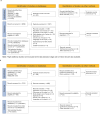A Systematic Literature Review of the Humanistic, Economic, Sociodemographic, and Environmental Burden Associated with Severe COPD
- PMID: 40692741
- PMCID: PMC12278951
- DOI: 10.2147/COPD.S510623
A Systematic Literature Review of the Humanistic, Economic, Sociodemographic, and Environmental Burden Associated with Severe COPD
Abstract
Chronic obstructive pulmonary disease (COPD) is a highly prevalent and progressive disease, hence greater understanding of its humanistic, economic, and environmental impact is essential for guiding effective management strategies. A systematic literature review (SLR; 2021-2023), complemented with a targeted literature review (TLR; 2013-2023) identified 2039 publications on the economic and humanistic burden of severe COPD. Additionally, an SLR and complementary TLR to evaluate the impact of environmental and sociodemographic factors on COPD (2013-2023), identified 1018 records. All searches were conducted on November 17, 2023. After applying prespecified selection criteria, 50 studies reporting on the humanistic and economic impact of COPD, and six studies on the environmental and sociodemographic impact, were selected. Severe COPD significantly impairs health-related quality of life, exerting effects on physical and psychological well-being, with a progressive decline as COPD worsens from mild to very severe. Evidence indicates that there is a significant burden of disease due to exacerbations of COPD, with their frequency and severity increasing with disease progression, and an increased mortality risk associated with very severe versus severe COPD. The studies reported a high frequency of healthcare resource utilization, including primary care visits, emergency department visits, and hospitalizations among patients with severe COPD, all of which contribute to a significant economic burden, particularly in patients with advanced disease. Environmental factors demonstrated diverse impacts on outcomes for individuals with severe COPD, varying by type of pollutant, disease severity, and patient characteristics. Studies examining the sociodemographic impact of underserved populations on the burden of severe COPD were not identified. Severe COPD is a multifaceted disease that imposes considerable humanistic and economic impact on both patients and healthcare systems. Further work is needed to understand the impact of environmental and sociodemographic factors on the burden of COPD, with such insights ultimately optimizing patient care.
Keywords: COPD; costs; environmental impact; healthcare resource utilization; quality of life.
© 2025 Vlachaki et al.
Conflict of interest statement
Robert A. Wise receives research grant support from AstraZeneca, Chiesi, Sanofi-Regeneron, and Verona; and consulting fees for serving on DSMB or Clinical Endpoint Committees from AstraZeneca, Boehringer Ingelheim, Chiesi, Galderma, Kamada, Pulmonx, and Savara. Jennifer K. Quint has been supported by institutional research grants from AstraZeneca, Boehringer Ingelheim, GlaxoSmithKline, Health Data Research, Insmed, Medical Research Council, NIHR, and Sanofi; and received personal fees for advisory board participation, consultancy or speaking fees from AstraZeneca, Boehringer Ingelheim, Chiesi, GlaxoSmithKline, and Sanofi. Ioanna Vlachaki, Alessandra Madoni, Simon Donhauser, and Ulrica Scaffidi Argentina are employees of Chiesi Farmaceutici S.p.A, the funder of this work. Jahangir Nabi Mir is an employee of IQVIA, which received funds from Chiesi Farmaceutici S.p.A for the conduct of this work. The authors report no other conflict of interest to disclose.
Figures



Similar articles
-
A systematic review of the humanistic, economic, sociodemographic, and environmental burden of severe/difficult-to-treat asthma.Curr Med Res Opin. 2025 Jun;41(6):1075-1095. doi: 10.1080/03007995.2025.2513963. Epub 2025 Jun 18. Curr Med Res Opin. 2025. PMID: 40501278 Review.
-
Tiotropium versus long-acting beta-agonists for stable chronic obstructive pulmonary disease.Cochrane Database Syst Rev. 2012 Sep 12;2012(9):CD009157. doi: 10.1002/14651858.CD009157.pub2. Cochrane Database Syst Rev. 2012. PMID: 22972134 Free PMC article.
-
Computer and mobile technology interventions for self-management in chronic obstructive pulmonary disease.Cochrane Database Syst Rev. 2017 May 23;5(5):CD011425. doi: 10.1002/14651858.CD011425.pub2. Cochrane Database Syst Rev. 2017. PMID: 28535331 Free PMC article.
-
Exploring the Economic Burden of Pulmonary Arterial Hypertension and Its Relation to Disease Severity and Treatment Escalation: A Systematic Literature Review.Pharmacoeconomics. 2025 Jul;43(7):741-760. doi: 10.1007/s40273-025-01492-1. Epub 2025 Apr 17. Pharmacoeconomics. 2025. PMID: 40244370 Free PMC article.
-
Supported self-management for patients with moderate to severe chronic obstructive pulmonary disease (COPD): an evidence synthesis and economic analysis.Health Technol Assess. 2015 May;19(36):1-516. doi: 10.3310/hta19360. Health Technol Assess. 2015. PMID: 25980984 Free PMC article.
References
-
- World Health Organization. Chronic obstructive pulmonary disease (COPD) factsheet; November 6, 2024. Available from: https://www.who.int/news-room/fact-sheets/detail/chronic-obstructive-pul...). Accessed April 28, 2025.
-
- Global Initiative for Chronic Obstructive Lung Disease. Global strategy for prevention, diagnosis and management of COPD: 2024 report. 2024. Available from: https://goldcopd.org/2024-gold-report/. Accessed April 28, 2025.
-
- World Health Organization. Smoking is the leading cause of chronic obstructive pulmonary disease. Departmental update. November 15, 2023. Available from: https://www.who.int/news/item/15-11-2023-smoking-is-the-leading-cause-of.... Accessed April 28, 2025.
Publication types
MeSH terms
LinkOut - more resources
Full Text Sources
Medical

